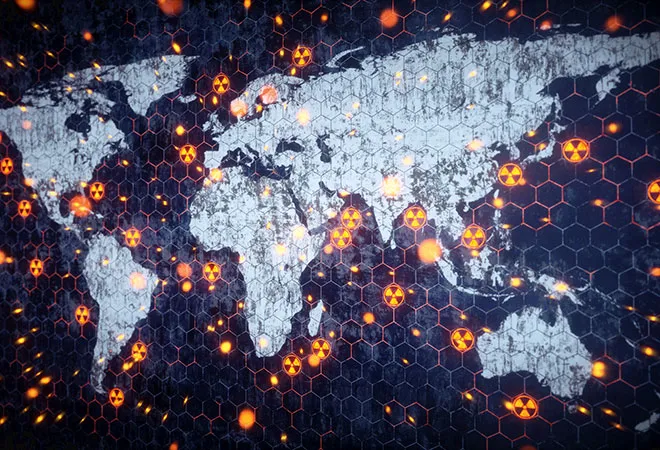Conversations around nuclear risks and the need for strategic stability have picked up momentum in the run up to the 2020 Nuclear Nonproliferation Treaty (NPT) Review Conference. Nuclear risks are changing for the worse because of geopolitical and technological changes, but the latter, in particular, needs to be addressed much more directly.
As far as the geopolitical dynamics are concerned, the shift in the global balance of power equations has meant that rule-making and enforcement have become the victims of great power politics because both rule-making and enforcement require some consensus among powers. But a second significant factor should be noted that could also lead to possible breakdown in nuclear deterrence: The impact of new technologies.
Emerging technologies such as Artificial Intelligence (AI) and hypersonic weapons, among others, are posing new questions to the traditional understanding of stability and deterrence. These emerging technologies are unfortunately not being discussed enough within Track 1 NPT platforms as directly as they should be. It can, however, be argued that these new technologies could increase regional and global nuclear insecurities and therefore it is necessary to discuss this more seriously in order to manage the risks associated with nuclear weapons.
Emerging technologies such as Artificial Intelligence (AI) and hypersonic weapons, among others, are posing new questions to the traditional understanding of stability and deterrence.
The development of hypersonic weapons could potentially have a big impact on nuclear stability. A key problem here is that such weapons can increase the possibility of surprise attacks because of the difficulty of detecting and countering them. They thus present the possibility of offering a temptation to attack first in the hope of decapitating the enemy leadership or even destroying second-strike nuclear retaliatory capabilities. Even if states do not plan such attacks, the fear that they may do so could drive potential targets to develop riskier nuclear operational plans, such as launch on warning.
The development of hypersonic weapons could potentially have a big impact on nuclear stability. A key problem here is that such weapons can increase the possibility of surprise attacks because of the difficulty of detecting and countering them.
Alternatively, it could also spur nations with smaller nuclear arsenals, such as China, to increase the size of their nuclear forces so that at least some survive such a first strike. This could lead to a destabilizing arms race spiral between key great powers, all of whom are working on developing these weapons.
An additional problem is that hyper-sonic weapons potentially blur the line between conventional and nuclear weapons, which will also increase instability because of the discrimination problem. It is more stable if early warning systems can clearly distinguish between a nuclear attack and a conventional one. If the same system can undertake both conventional strikes and nuclear attacks, a prudent defense system will have to assume that any attack it detects is a nuclear attack because the risks of assuming the alternative will be too high. Though this is a problem that is not confined to hyper-sonic weapons, the combination of the risk of a first strike combined with the discrimination problem makes the danger particularly acute.
Hyper-sonic weapons potentially blur the line between conventional and nuclear weapons, which will also increase instability because of the discrimination problem.
Another evolving technology is Ballistic Missile Defence (BMD), which also has similar problems. Nuclear deterrence and stability are based on mutual vulnerability, and BMDs threaten to undo this key source of stability, with unpredictable consequences. This is not a new problem of course: the fear that one side might develop a strategic technological advantage was one reason for the Cold War U.S.-Soviet ABM Treaty. It might be time to revisit the possibility of developing a wider ABM treaty-like instrument in order to avoid a larger technology arms race as ballistic missile defense technologies slowly improve.
It might be time to revisit the possibility of developing a wider ABM treaty-like instrument in order to avoid a larger technology arms race as ballistic missile defense technologies slowly improve.
A third area is outer space, which Russia has been raising repeatedly in the NPT platforms. The increasing use of and reliance on space for national security missions has led states to develop counter-space capabilities to disrupt, deny, degrade or destroy space systems. These include both kinetic and non-kinetic means.
Counter-space capabilities such as anti-satellites (ASAT) add an inherently destabilizing dimension to outer space security. But these are also a problem for nuclear stability because nuclear early warning as well as command and control systems depend on space-based assets far more today than a few decades ago. While these are not new capabilities – the United States and Soviet Union had conducted several ASAT tests in the 1970s and 1980s – the greater reliance on space assets increases nuclear vulnerabilities.
The NPT faces myriad problems, of course, and many will be discussed in the coming deliberations. But these emerging technologies represent a danger that should not be minimized in the debates about how much has been achieved, whether all sides have lived up to their end of the NPT bargain (especially nuclear weapons states), and how to proceed forward.
This commentary originally appeared in The Diplomat.
The views expressed above belong to the author(s). ORF research and analyses now available on Telegram! Click here to access our curated content — blogs, longforms and interviews.




 PREV
PREV


